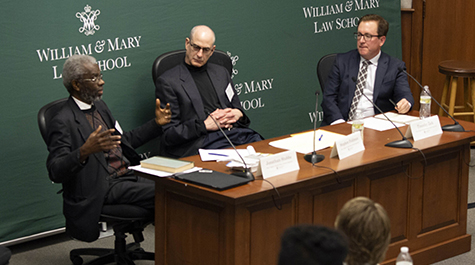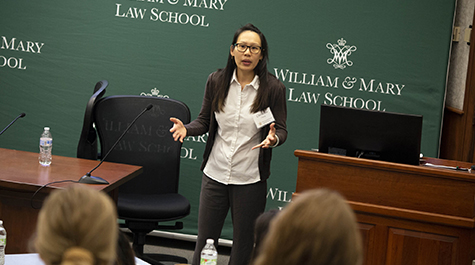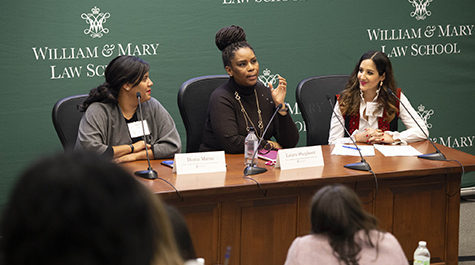William & Mary Journal of Race, Gender, and Social Justice Holds Symposium on the First Amendment Marketplace
On Friday, February 28, the William & Mary Journal of Race, Gender, and Social Justice (RGSJ) held its annual symposium entitled “First Amendment Marketplace Morass: Free Speech Jurisprudence and Its Interactions with Social Justice.”
The event anchored itself in discussions surrounding how the First Amendment of the U.S. Constitution has been used both to bolster and protect the rights of various groups in society, and, more commonly, to disempower groups and their corresponding civil and human rights.
Eleven speakers came from all over the country, each bringing a diverse perspective on the issue of social justice and First Amendment jurisprudence.
Nicole Ligon and Christina Chong began the symposium with a panel on “Free Speech and Diversity in the Performing Arts,” speaking to issues of representation on the stage. Ligon, a lecturing fellow and supervising attorney of the First Amendment Clinic at Duke Law School, framed this discussion around racial preferences within casting practices, using the Broadway musical Hamilton as her central case study.
Chong, an assistant professor of law and assistant director of the Law+Plus and Bar+Plus programs at the University of San Francisco, brought in empirical data on such representation, joining Ligon on discussing how the First Amendment has played a role in representation of minorities (or lack thereof).
The symposium then turned to discussions of free speech and power politics as William & Mary Law’s own Professor Timothy Zick moderated a panel with Jonathan Stubbs of the University of Richmond Law School and Stephen Feldman of the University of Wyoming College of Law. Stubbs shared a legal history of how the free press, protected under the First Amendment, has been used to oppress racial minorities; and Feldman spoke to the formalism of the U.S. Supreme Court in First Amendment cases as a tool for continued oppression of groups’ free speech rights.
Matthew Lawrence, a solo practitioner in Mississippi and Ph.D. candidate in psychology at the University of Southern Mississippi, next spoke to the effects of rejecting mind-body dualism on U.S. law. Specifically, he centered his discussion in the need to create a robust negative right of children to be free from their parents’ racism as a practice of their First Amendment rights.
Jason Shepard and Jeff Kosbie then spoke to the intersection of free speech and LGBTQ+ advocacy. Shepard, a media law scholar, associate professor and chair of the Department of Communications at California State University, Fullerton, provided a legal history of how the First Amendment disempowered the LGBTQ+ community in the case of suppressing the publication and distribution of homophile magazines. Kosbie, an attorney for Gibbs Law Group, spoke to how the suppression of gender nonconformity is a violation of free speech.
Lisa Crooms-Robinson gave journal members a reason to dance in protest as she spoke to how the First Amendment has been used to disempower even the narrowest of minority sub-groups while leaving others alone. She referred specifically to how the First Amendment protected the words of black musicians and rappers even as it suppressed as “obscene” the female strippers who dance to those words.
Rounding off the event was a panel of William & Mary Law’s own Associate Dean for Student Services Laura Shepherd and William & Mary’s former Chief Diversity Officer, Dania Matos, speaking to difficult questions on the intersection of free speech and the First Amendment on campuses, particularly tackling the issue of hate speech.
The speakers brought diverse viewpoints and discussion points, reminding all symposium participants that the protections that exist in the Bill of Rights have not applied to all equally, and thus it is the responsibility of citizen lawyers to change this trend.
Deeply embedded in the history of female and minority participation at the Law School and in legal academia, RGSJ (previously known as the Journal of Women & the Law) calls upon the institution and legal academia as a whole through its volumes and symposia to bring underrepresented issues and underdiscussed topics to the forefront of legal conscious to spark change. The special issue of RGSJ (Vol. 26:1) is available online through William & Mary Law School’s Scholarship Repository.
About William & Mary Law School
Thomas Jefferson founded William & Mary Law School in 1779 to train leaders for the new nation. Now in its third century, America's oldest law school continues its historic mission of educating citizen lawyers who are prepared both to lead and to serve.


